Niigata: Japan's North Asia Hub
Back to Contents of Issue: July 2003
|
|
|
|
by John Dodd |
|
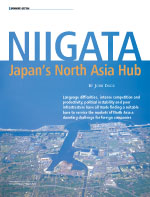 FOR FOREIGN BUSINESSES IN North Asia, the conventional compromise for establishing a locus of operations has been Tokyo or Seoul, despite the exorbitant costs of setting up in either location. FOR FOREIGN BUSINESSES IN North Asia, the conventional compromise for establishing a locus of operations has been Tokyo or Seoul, despite the exorbitant costs of setting up in either location.
However, there is another choice, and one that you may not have considered -- Niigata Prefecture. Serviced by a world-class infrastructure and facilities for both sea and air, the prefecture of Niigata is centered in the middle of the North Asia trading region, only two hours' flight from Seoul, Korea, 1 hour and 45 minutes from Harbin, China, and 2 hours by Shinkansen from Tokyo. Niigata is also just a 3 or 4 hour drive from Osaka and Nagoya.
Setting up in Niigata is not just about location, of course. Finances and operations are crucial. Niigata Prefecture, along with the local city government, understands the costs and difficulties of a company CEO choosing a regional location over one of the major urban centers such as Tokyo or Osaka. On a purely financial plane, Niigata offers excellent incentive packages, including low interest loans, extensive subsidies and tax breaks at the prefectural and local metropolitan levels. Furthermore, the costs of both land and labor are an average 30 to 40 percent and 10 to 15 percent, respectively, cheaper than they are in major centers such as Tokyo. On an operations plane, Niigata is extremely well serviced in terms of utilities -- including power and industrial water supplies, as well as excellent port facilities and road/air access.
History
Attractive Land Prices
Workforce
Niigata city is well serviced by tertiary education institutions, including 10 universities and two-year colleges (approximately 15,500 students) and 30 vocational colleges (approximately 11,500 students). To give some idea of the skill sets of newly hired people in the area, there were 43,300 new hires in 2000 alone. Of these, almost half, or 20,500, were employed in manufacturing. About 7 percent, or 3,450 people, were in engineering, with the remainder in administration, sales and services.
For example, a company wanting to set up its facilities in the Niigata Prefecture Central industrial park would have the following incentives. Other industrial parks have similar or even more advantageous mixes of loans, subsidies and tax exemptions:
CENTRAL GOVERNMENT
PREFECTURAL GOVERNMENT
MITSUKE CITY
As an aside, the Niigata Chamber of Commerce and Industry was established in July 1896, making it one of the oldest organizations of its type in Japan. The Chamber supplements the activities of the regional and local governments with such services as foreign trade data collection, consulting for small and medium-sized businesses and the initiation of joint projects between members.
In addition, Niigata Prefecture operates an English language Web site called the Niigata Business Net Plaza (www.niigata-bnp.com/e/), which seeks to connect local businesses with overseas customers and partners. Companies log their information on the Web site and the prefectural staff translates the information into English, Chinese and Korean -- following up through prefectural offices in Seoul and Dalian to arrange international trade fairs and economic missions. Once located in Niigata, foreign capital companies are welcome to take advantage of services and facilities such as the Net Plaza Web site, just as if they were set up locally. @
A number of foreign companies have already chosen to set up operations in Niigata. Among these is a subsidiary of the world's largest aluminum producer, Alcoa. We talked to Alcoa Wheel Products Japan's former CEO, Mike Swain, to find out why the company chose Niigata.
JI: Can you give us some background on the company itself?
AW: Alcoa Wheel Products International is a $600 million Division of Alcoa, the aluminum conglomerate. We started out manufacturing forged aluminum wheels for the US trucking industry in the 40s. Due to deregulation in the industry, truck drivers were looking for an edge in lowering costs and found that aluminum wheels were lighter than steel, have better fatigue characteristics and lower maintenance, and also run truer, thus reducing tire wear.
JI: Moving from steel to aluminum sounds logical. How long did it take for the majority of the industry to go that route?
AW: Actually, it took about 30 years in the US. However, in Europe and Australia, trucking firms were a lot quicker to see the advantages. In Australia the penetration of aluminum product is now almost 70 percent, of which our market share is quite high.
JI: When did you start operations in Japan and the region?
AW: We started doing business in Japan in the mid 80s, exporting to a distributor located here. Then, in 1992, we established a joint venture with TOPY Industries, the largest producer of wheels in Japan. In 1998 we decided to go independent and set up our own operation. Alcoa Wheel Products Japan Limited was established in August 2000.
JI: How did you get interested in Niigata?
AW: Before going independent, we realized our products, which are four to five times more expensive upfront than steel products, were perceived by truck producers as being foreign and possibly not of the same quality as locally made products. So we concluded that we needed to manufacture here in Japan -- to prove our commitment to the market and improve our quality.
In 1999 we tried to acquire a Japanese wheel company. That didn't work out, but we learned a lot about doing business in Japan during the acquisition attempt. This made us confident that we could set up our own operation in Japan. Another Alcoa business unit already had a small manufacturing operation in Niigata. We toured this site and we liked the region, so we decided to set up here.
JI: Were there any other factors involved in your selecting Joetsu in Niigata?
AW: Definitely. First, we were lucky enough to find an unused facility provided by Mitsubishi Chemical -- who was already hosting the other Alcoa business unit at the same location -- so we had a relationship. Mitsubishi Chemical used to operate an aluminum smelter at this site. This smelter was shut down in the early 80s due to high energy costs. So Mitsubishi Chemical set up the Joetsu Techno Center industrial park on the site of the former aluminum smelting plant. This location has excellent infrastructure and is ideal for what we do.
JI: And what do you do? Are you forging wheels in Joetsu?
AW: No, we machine and polish unfinished wheel forgings, which we call 'cans.' These originally come from our Hungary plant. The finishing process involves drilling, machining, polishing and packaging -- which we do in Joetsu.
The shipment of forged cans from Hungary to Japan is another reason we chose Niigata. With the deep water port adjacent to the Joetsu Techno Center, the overall economics of shipping to Niigata are very favorable compared to other locations in Japan, such as Tokyo or Yokohama.
JI: Were port facilities part of the decision as well?
AW: Well, the port facilities are excellent all the way up and down the Japan Sea coastline, and we had a selection of several ports in Niigata alone. However, the deep water port at Joetsu is practically adjacent to the MCC Joetsu Techno Center site, so this works out quite well for us.
JI: What other advantages are to be had in Niigata?
AW: Lower power supply, tax and labor costs are some of the advantages that I can think of just offhand. Basically, if you don't need to be in Tokyo, Niigata is a good place to be located. |
|
Note: The function "email this page" is currently not supported for this page.


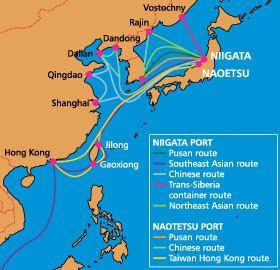 Geography
Geography
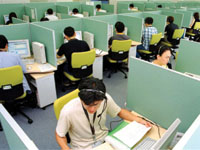 Infrastructure and Access
Infrastructure and Access
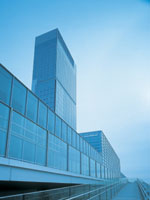 Servicing the many needs of businesses operating in Niigata, including those arriving at the industrial parks, is the new "Toki Messe" convention center (shown here). The Messe will be a command post for nonprofit companies, the local government, chambers of commerce, a passport center and an international conference center. Private companies are of course welcome.
Servicing the many needs of businesses operating in Niigata, including those arriving at the industrial parks, is the new "Toki Messe" convention center (shown here). The Messe will be a command post for nonprofit companies, the local government, chambers of commerce, a passport center and an international conference center. Private companies are of course welcome.
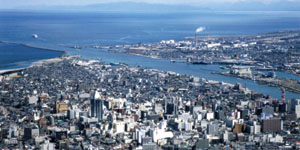 Incentives
Incentives
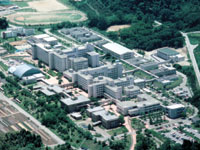 Business Support and Further Information
Business Support and Further Information



